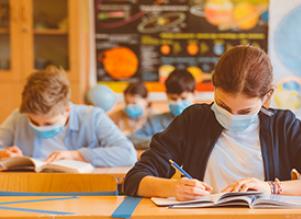9/9/2020
Slowing the COVID Slide: 6 Action Steps for Educators This Fall
Unlike the summer break, federal holidays, and other scheduled interruptions in instruction, the shutdowns of spring 2020 were wholly unplanned. And while some school communities were able to quickly adapt to virtual learning, others experienced steep learning losses.
This year, the fall semester must consider both the summer slide and the "COVID slide." Here are six actions educators can take to facilitate trauma-processing, assess learning losses, and address the pre-existing disparities exacerbated by shutdowns.
Processing trauma
The most marked difference between the COVID slide and the typical summer slide is the former's association with widespread trauma. Some members of the school community may have lost loved ones, struggled with their own health, or faced coronavirus-related financial instability—and even those who weathered the past few months relatively unscathed likely experienced feelings of loss related to the spring semester's abrupt and premature end.
In the new academic year, educators should be empowered with trauma-informed teaching strategies that involve prioritizing relationships above content. Although it may be tempting to focus on addressing academic losses, students' social and emotional well-being must come first. Ultimately, the safer and more secure students feel, the better they will be able to focus on their schoolwork.
Indeed, a 2017 study found that teachers who took a social-emotional learning (SEL) approach saw increased academic performance, decreased disruptive behaviors, and reduced emotional distress among 97,000 K–12 student participants. With this in mind, we recommend the following actions:
-
Action: Join forces with guidance counselors, community services, and other educators to create a support network. Because no single teacher can fully address the emotional needs of 20 to 30 students in a classroom, schools should view applying a successful trauma-informed approach as a team effort. More specifically, Edutopia recommended creating support networks among staff (such as small groups or restorative circles) and holding staff-wide discussions on how to prioritize SEL.
-
Action: Access professional learning opportunities for trauma-informed teaching. School or district administrators may be able to provide resources on teaching students amid an ongoing crisis, while school guidance counselors and community outreach coordinators could offer SEL curriculum ideas and support.
Assessing education needs
It stands to reason that the combined summer and COVID slides will result in more pronounced learning losses than those associated with a regular summer break. However, the precise degree of these losses remains unclear at the time of writing, and will likely vary from school to school and student to student.
In May, the nonprofit NWEA estimated that students would see only 40% to 60% of the learning gains expected from a typical school year, while researchers who study the aftermath of natural disasters have warned of the potential for longer-term effects on learning. According to Tulane University economics professor Doug Harris, students displaced by Hurricane Katrina in 2005 took two years to catch up academically.
As educators work to gauge learning loss and help students succeed this academic year, these two actions will be even more important than usual:
-
Action: Collaborate across grade levels. What material did students learn in the classroom last year? What items on the curriculum were dropped during school closures or covered via virtual learning? Establishing transparency between grade-level teams will allow educators to prepare for review or reteaching as needed.
-
Action: Plan informal assessments for the first weeks of school. In lieu of conducting formal academic assessments that take time to administer and analyze, educators can use activities like these five fun literacy games to determine students’ level of subject mastery and inform subsequent instruction.
Addressing disparities
Due to resource and infrastructure disparities across the nation, students and staff in some districts scrambled to borrow devices, share hotspots, and print packets following last spring's school shutdowns, while others enjoyed easier access to the tools and connectivity they needed to continue teaching and learning. Although few educators could have predicted that last semester would have been derailed in such a manner, those preparing for the upcoming academic year can tap into the benefits of both hindsight and forethought.
-
Action: Plan for virtual learning and alternatives. Between educators' safety concerns and parents' unwillingness to send students back to school full-time, the 2020-2021 academic year is likely to consist of hybrid or online-only learning for many. As educators gear up for the fall, reflecting on the spring's virtual learning successes and challenges is key, particularly with regard to how well students were able to access remote learning and who needs specialized accommodations and support.
-
Action: Determine effective methods of communication for students and families with special learning needs. Virtual learning is likely to play a large role in the coming school year, so it is imperative that educators create a more interactive, responsive, and sensitive system of online home-school communication that takes individual students' needs into account. For instance, English language learners and students with disabilities may need more visual support or individualized material while learning remotely, while families who are less technologically proficient might benefit from a workshop to explain the basics of virtual learning.
The bottom line
For school communities across the country, the 2020–2021 academic year will present unique yet surmountable challenges. By taking cues from those with experience teaching through a crisis, today's educators can apply trauma-informed teaching practices, quick and accurate informal education assessments, and a willingness to see and address disparities to help stem the COVID slide.


